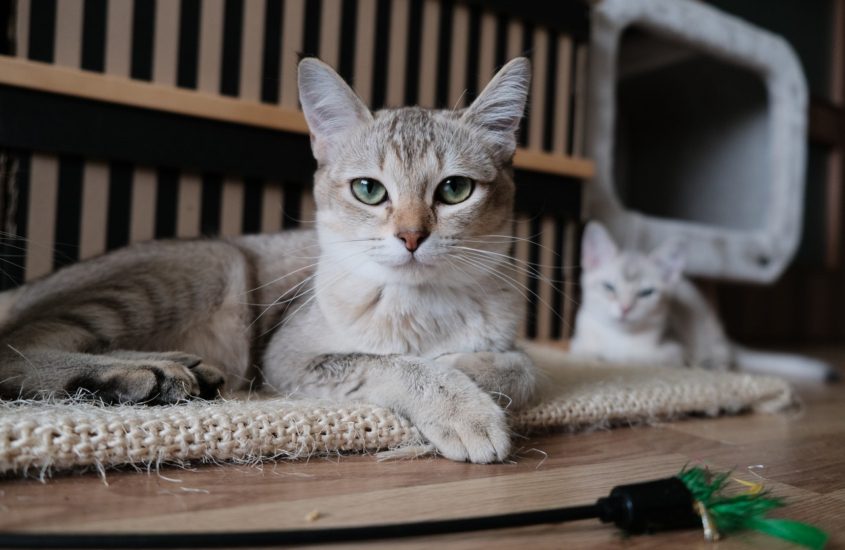Our Cat Care Course is Purrrfect for Animal Lovers!
Explore a new income stream, employment opportunity or understand and care for your own pet better with this cat care course. Ideal for cat owners, breeders, pet shop owners and attendants or those who work in animal welfare, our Domestic Cat Care course will give you insights into the primary care of domestic cats – including diet, shelter, grooming and housebreaking. You will also study complex feline care – from understanding digestive and reproductive health to illnesses, emergency medicine and care, problem behaviour and specialised dietary requirement.
You will also learn about breeding and raising kittens, from ethical considerations to genetics and socialisation, and how to establish a business in the feline services industry, including grooming, boarding, retail and manufacturing, therapy cats, pet funerals and more.
Learning Outcomes
Outcomes achieved by undertaking a cat care course include:
- Learning about basic feline needs and the basic duets of a cat owner
- Exploring food, water, shelter and containment, grooming, bathing and claw trimming
- Gaining an understanding of travel, housebreaking and health care for sick cats
- Studying how to introduce a new cat at home
- Examining cats and dogs and cats with babies and children
- Understanding cat breeds – pedigrees and non-pedigrees
- Attaining knowledge of feline biology
- Gaining insights into cats’ skin, eyes, ears, nose, mouth, tongue, teeth and gums
- Learning about the digestive and reproductive systems
- Exploring females (Queens) and males (Toms)
- Gaining an understanding of domestic cat breeds and international and national associations
- Studying long haired, semi-long haired and short-haired breeds.
- Examining Persian, Maine Coon, Birman, Balinese, Ragdoll (Ragamuffin), York Chocolate, American Shorthair, Cornish Rex and Russian Blue
- Understanding Siamese, Sphynx, Manx, Scottish Fold, Japanese Bobtail, Egyptian Mau and Singapura
- Attaining knowledge of characteristics, common health problems, personality and temperaments and care
- Gaining insights into history and background
- Learning about feline health care, preventative care, vaccinations and how to recognise ill health
- Exploring how to deal with emergencies, artificial breathing and heart massage and how to induce vomiting
- Gaining an understanding of how to deal with burns, wounds, dehydration, hypothermia, poisoning, wounds, shock (and many more)
- Studying restraining for treatment and the transportation of an injured cat
- Examining bandaging and de-sexing
- Understanding feline illnesses
- Attaining knowledge of internal parasites including roundworms, hookworms, tapeworms and whipworms
- Gaining insights into lungworms, stomach worms, bladder worms and flukes
- Learning about worm treatments and external (exo-) parasites
- Examining how to breed and raise kittens and ethics in animal breeding
- Understanding genes, sexual behaviour and the socialisation of kittens
- Attaining knowledge of legislation
- Gaining insights into meiosis and sexual behaviour
- Learning about feline services including grooming services for short and long-haired cats
- Examining laws and small business, the importance of keeping records and how to buy an established business
- Understanding how to buy a franchise and approaches to business planning
And more!
The Worlds Rarest Cats
In our cat care course you will learn about a wide range of cat species, but here are some of the rarer varieties from across the globe.
- Lykoi – One of the rarest cat breeds, it is also known as the werewolf cat breed. They are a domestic, short-hair cat with a natural genetic mutation that gives them a distinctive and somewhat creepy appearance!
- Savannah – Also known as the Ashera cat, this is a hybrid cat breed that is a cross between a domestic cat and an African Serval. These tall and slim cats display large ears and a spotted coat that give them a distinctively wild appearance.
- Chausie – This is another hybrid cat breed that is a cross between a domestic cat and a Felis Chaus jungle cat. They are tall and slim with broad ears, very long legs and prominent cheekbones.
- Serengeti – This breed is a cross between an Oriental Shorthair and a Bengal cat. They are spotted, slim and slinky and beautiful to look at.
- Kurilian Bobtail – These cats have fluffy coats and pom-pom tails. They love water and are active, loyal and friendly.
- Manx – This is a tailless cat that hails from the Isle of Man in the Irish Sea. Manx cats are smart and sometimes exhibit dog-like in behaviour.
- Ocicat – The Ocicat looks wild but is an entirely domesticated cat breed originating from a mix of Abyssinian, Siamese and silver tabby.
- Korat – These cats have sparkling green eyes and a heart-shaped face. They have been bred in Thailand for centuries and are loyal, dominating and intelligent.
- LaPerm – This breed is similar to Devon Rex and Cornish Rex however a dominant gene gives them a distinctive curly coat which resembles a salon fresh perm!
- Somali – Often referred to as the long-haired Abyssinian, a rarely occurring recessive gene gives the Somali cat its lovely long coat.
Fascinating Cat Facts
After some motivation to undertake our cat care course? Read on …
- In terms of development, the first year of a cat’s life is equal to the first 15 years of a human life. After its second year, a cat is 25 in human years. And after that, each year of a cat’s life is equal to about 7 human years.
- Cats can rotate their ears 180 degrees.
- The hearing of the average cat is at least five times keener than that of a human adult.
- A cat cannot see directly under its nose.
- Most cats have no eyelashes.
- Cats have five toes on each front paw, but only four on the back ones. It’s not uncommon, though, for cats to have extra toes.
- Cats spend between 30 to 50 percent of their day grooming themselves.
- Purring doesn’t always mean a cat is happy. Cats also make the sound when they’re sick, hurt, stressed or giving birth.
- A group of kittens is a kindle. A group of full-grown cats is called a clowder.
- If you love cats, you’re an ailurophile. It’s derived from the Greek word for cat, ailouros, and the suffix –phile, meaning “lover.”
- Cats first went to space in 1963. The feline’s name was Félicette and she made it safely to the ground following a parachute descent.
- The world’s oldest living cat is 31 years old. The average lifespan of a cat is 12 to 18 years.
- Cats don’t always land on their feet, however, more often than not all four paws end up touching the ground. This is because cats have a fantastic sense of balance, so they’re able to tell up from down and adjust their bodies accordingly.
- The musical Cats is based on a collection of author T.S. Eliot poems called Old Possum’s Book of Practical Cats which was published in 1939.
- One in 200 cats are believed to have asthma – and this number continues to rise among as they are more frequently exposed to dust, cigarette smoke, pollen and human dandruff.
- Ancient Egyptians loved cats and worshipped a half-feline goddess named Bastet. People who harmed or killed cats faced harsh legal sentences, including the death penalty.
- Cats are believed to be the only mammals that can’t taste sweetness.
- Your cat has more bones than you do – 244 compared to a human’s 206.
- Most cats don’t like getting wet because they lose control.
- Cats sweat through their paws and sometimes when they get very hot they pant.
- Beyond grooming all the time, a cat spends nearly two-thirds of its life asleep.
- Approximately 200 feral cats roam the grounds of Disneyland where they help control the amusement park’s rodent population.
- Quotation marks have a feline connection. The Hungarian word for “quotation marks,” macskaköröm, literally translates to “cat claws.”
- Cats can jump up to five times their own height.
- Their claws all curve downward, which means that they can’t climb down trees head first – they have to back down the trunk.
- Cats have whiskers on the backs of their front legs as well.
- They have the largest eyes relative to their head size of any mammal.
- Cats find it threatening when you make direct eye contact with them.
- Certain cats go crazy for foods you wouldn’t expect like potato chips and olives.
- Unlike humans, cats can drink sea water in order to survive.
- Cats dream, just like us!
- Every cat’s nose print is unique, much like human fingerprints.
Gain a comprehensive understanding of all aspects of cat care with a cat care course such as our Domestic Cat Care course.





